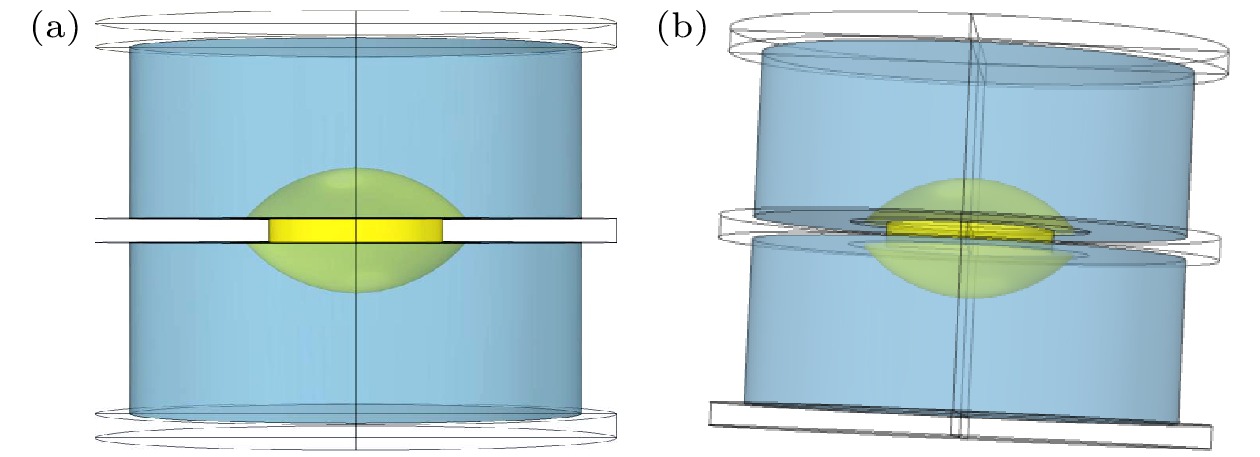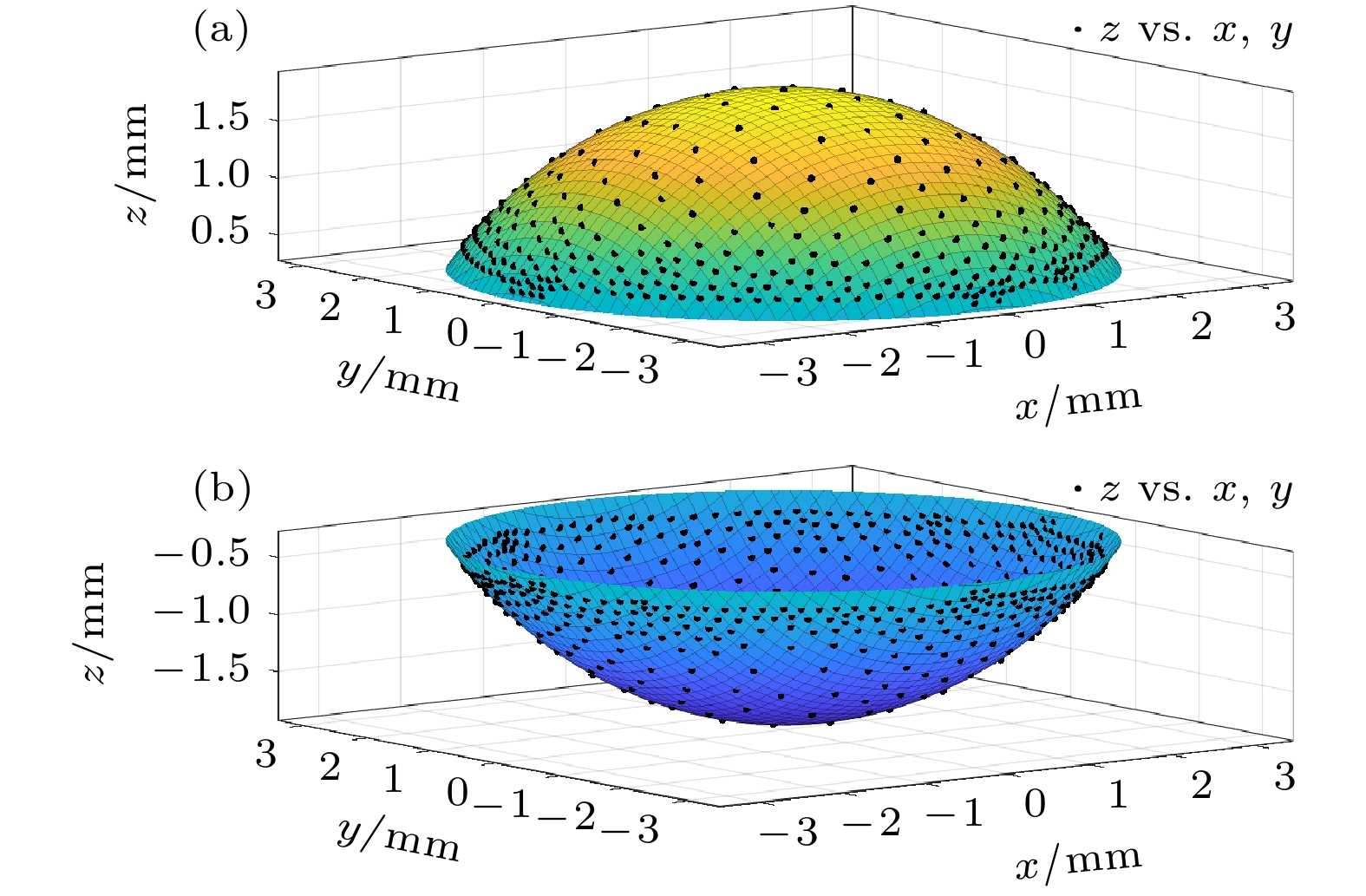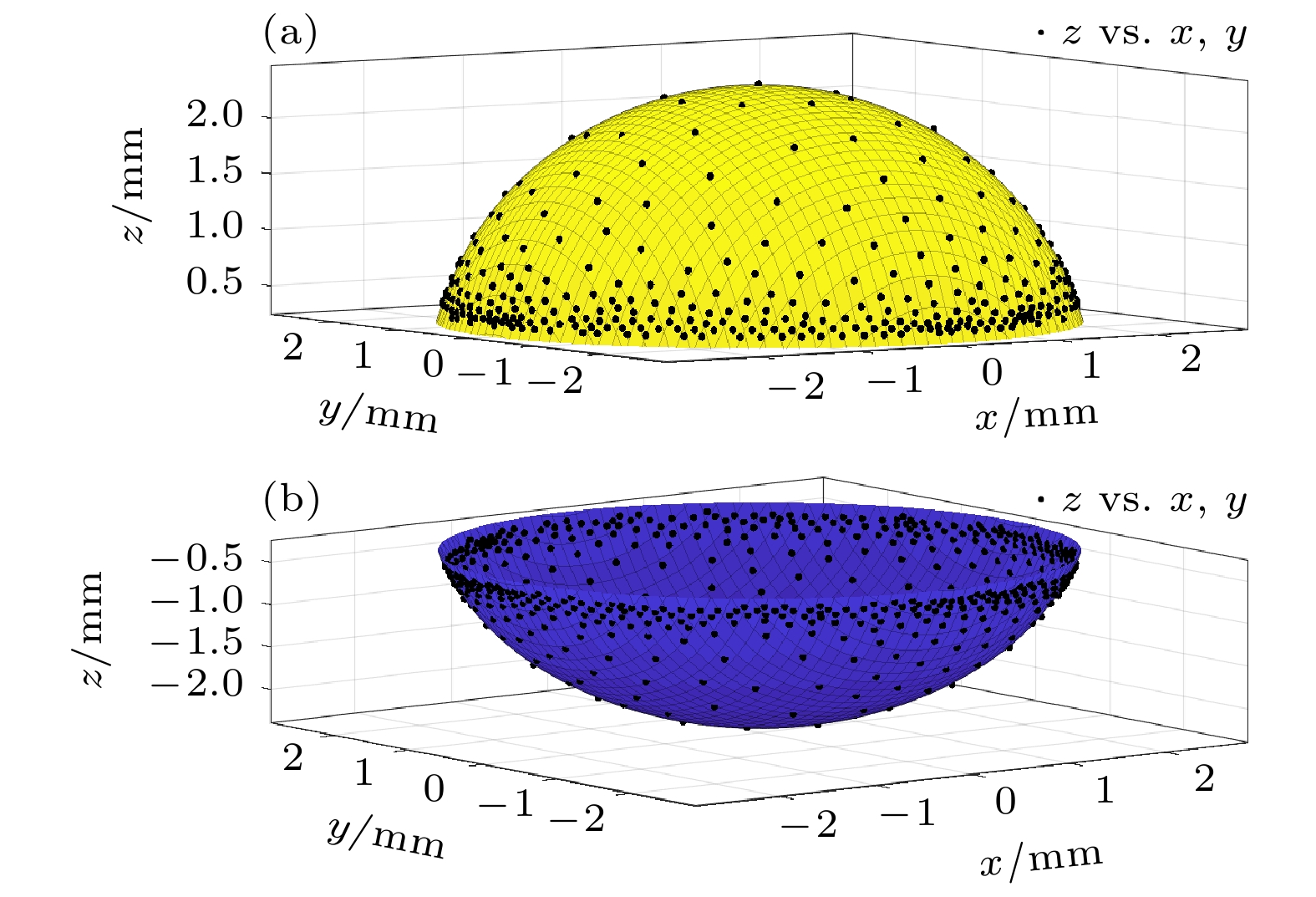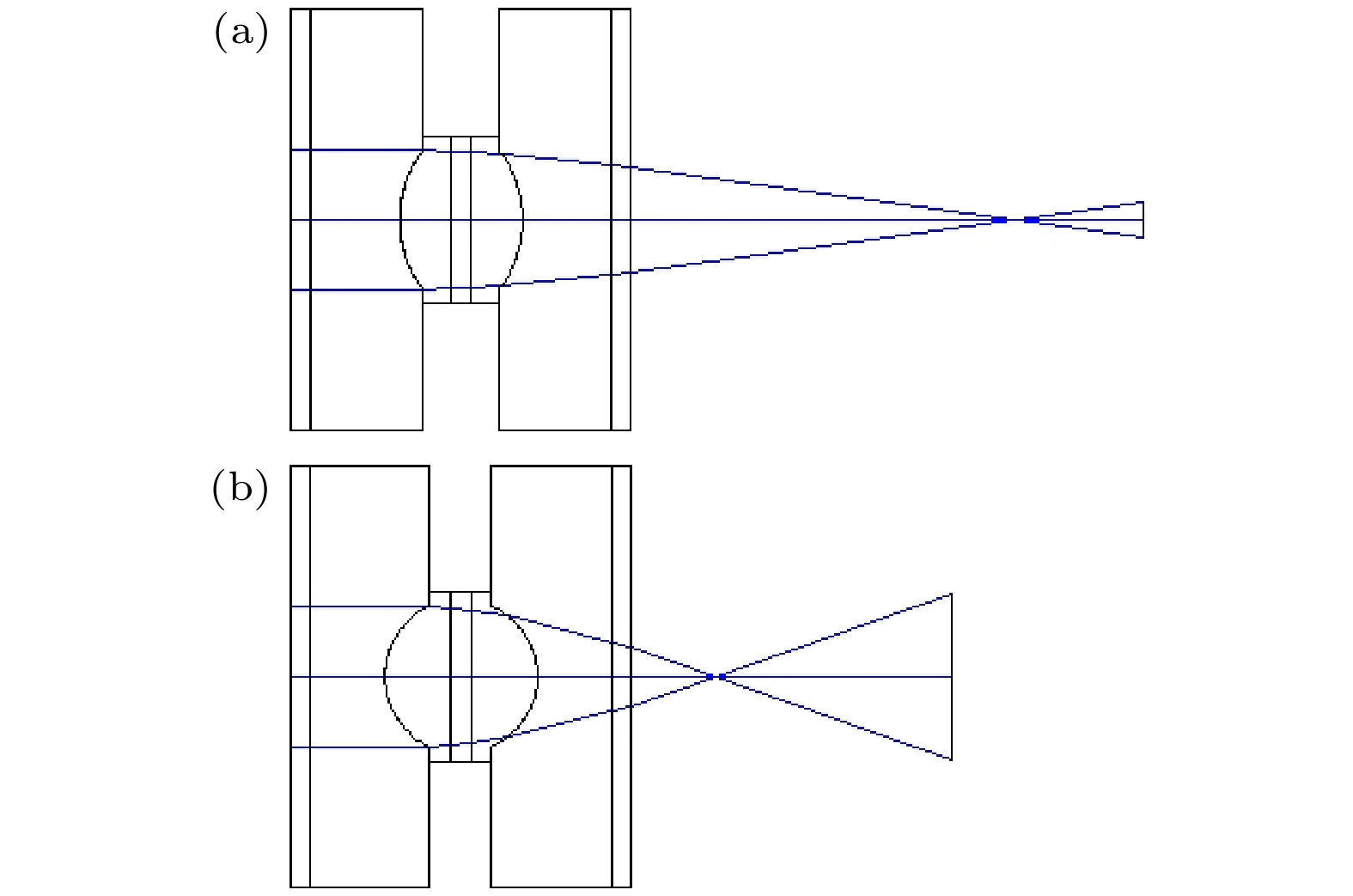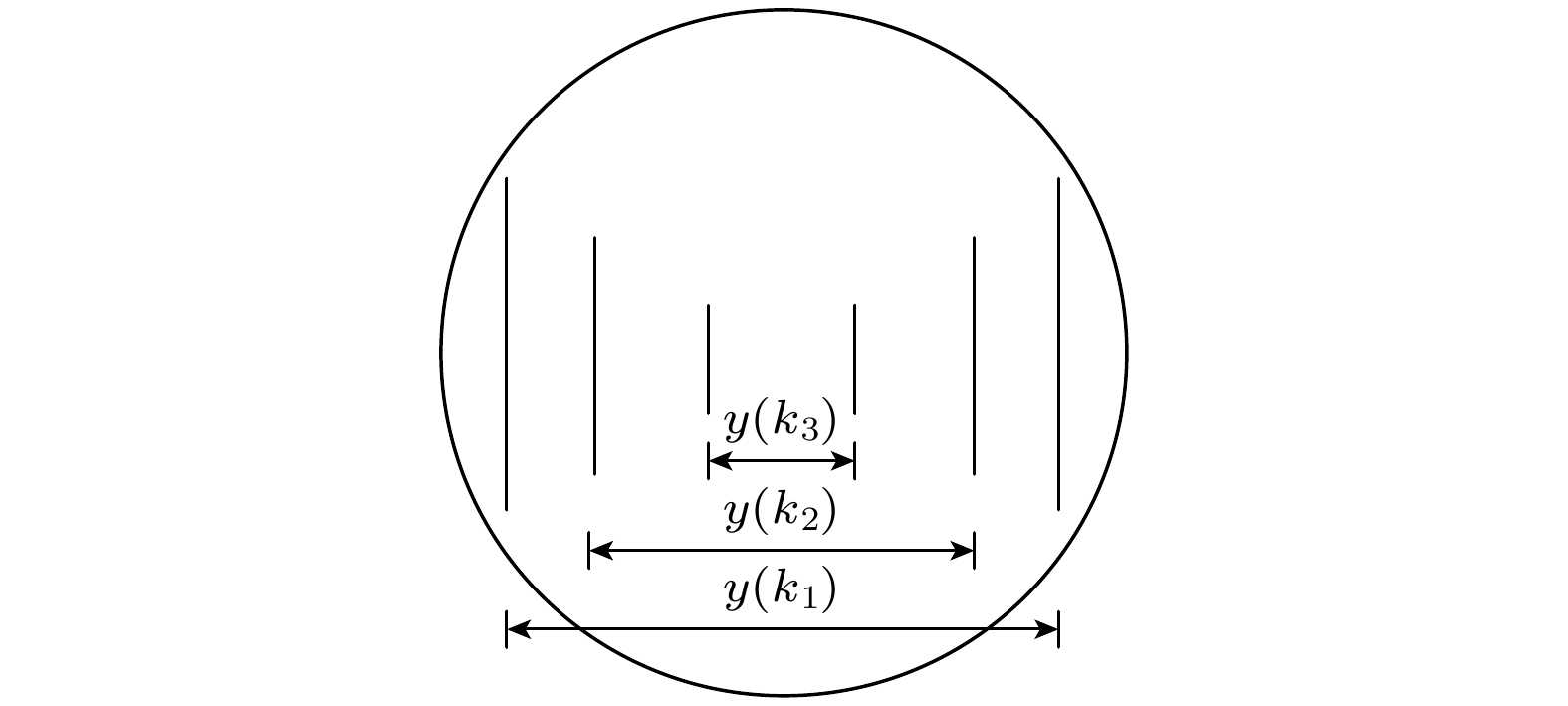-
基于平行平板电极的变焦液体透镜的有关研究, 通过应用介电泳效应, 提出了一种含有圆孔平板电极结构的双凸液体透镜模型, 是一种新型的三层液体透镜结构. 利用Comsol, Matlab和Zemax软件仿真分析了该模型在不同电压下的面型变化与成像光路, 得出其变焦范围为22.6—15.9 mm, 并对制备的器件进行具体的实验分析, 获得了不同电压下双凸液体透镜的液滴上下界面面型和该透镜的变焦范围23.8—17.5 mm, 与仿真结果基本一致, 而且其成像分辨率可达到45.255 lp/mm. 结果表明, 所提出的这种新型三层液体结构的双凸液体透镜具有结构简单、易于实现的特点, 而且具备良好的成像质量.In this paper, based on the research of zoom liquid lens with parallel plate electrode and the principle of dielectrophoresis, a model of the biconvex liquid lens with circular hole plate electrode structure is proposed, which is a novel three-layer liquid lens structure. The dielectrophoretic effect refers to the phenomenon that free dielectric molecules will be polarized and moved by the force in a non-uniform electric field, thus deforming the dielectric liquid. In the dielectrophoretic liquid lens, only two insulating liquid materials with large refractive index difference and dielectric constant difference need to be selected, which can increase the selection range of liquid materials. The liquid lens structure mainly consists of a piece of double-sided conductive flat plate ITO glass with a circular hole and two pieces of single-sided conductive flat plate ITO glass, which respectively form two sets of flat electrode structures to control the upper interface and lower interface of the liquid droplet. In this structure, the influences of the intermediate glass plate on the focus and imaging are reduced by using the flat plate electrode with circular hole. The theoretical analysis of the structure is carried out with simulation software. Firstly, the models of the biconvex liquid lens with circular hole plate electrode under different voltages are built with Comsol software, the data of upper interface and lower interface of the liquid droplet are exported. Then by using Matlab, the surface shapes of the upper interface and lower interface of the droplet are fitted and the corresponding aspheric coefficients are obtained. Finally, the optical models are built with Zemax software, the imaging optical paths and the variation range of focal length under different voltages are analyzed. On the basis of the simulation, the corresponding device is made, and the specific experimental analysis is carried out. The surface patterns of the upper interface and lower interfaces of the droplet of the biconvex liquid lens under different voltages are recorded, the focal length and imaging resolution of the liquid lens are measured. When the operating voltage is in a range of 0–260 V, the focal length varies from 23.8–17.5 mm, which is basically consistent with the simulation results (22.6–15.9 mm). The feasibility of the structure of the biconvex liquid lens with circular hole plate electrode structure is verified experimentally. The imaging resolution can reach 45.255 lp/mm. The results show that this proposed novel three-layer liquid structure of the biconvex liquid lens has the characteristics of simple structure, easy-to-realize and good imaging quality. Therefore, the research of this biconvex liquid lens can provide a new idea for expanding the high-resolution imaging research of liquid lenses and their applications.
-
Keywords:
- biconvex liquid lens /
- dielectric electrophoresis effect /
- zoom /
- image quality
[1] Zhao Z Z, Kuang F L, Zhang N H, Li L 2021 IEEE Photonics Technol. Lett. 33 1297
 Google Scholar
Google Scholar
[2] Liu J, Li H 2014 J. Opt. 3 25
[3] Liu C, Wang Q H, Yao L X, Wang M H 2014 Micromachines- Basel 5 496
 Google Scholar
Google Scholar
[4] Kopp D, Zappe H 2016 IEEE Photonics Technol. Lett. 28 597
 Google Scholar
Google Scholar
[5] Cheng C C, Chang C A, Yeh J A 2006 Opt. Express 14 4101
 Google Scholar
Google Scholar
[6] Ren H W, Xianyu H Q, Xu S, Wu S T 2008 Opt. Express 16 14954
 Google Scholar
Google Scholar
[7] Xu S, Lin Y J, Wu S T 2009 Opt. Express 17 10499
 Google Scholar
Google Scholar
[8] Lu Y S, Tu H E, Xu Y, Jiang H R 2013 Appl. Phys. Lett. 103 26113
 Google Scholar
Google Scholar
[9] Chen Q M, Li T, Li Z, Lu C, Zhang X 2018 Lab Chip. 18 3849
 Google Scholar
Google Scholar
[10] Kong M M, Zhu L F, Chen D, Liang Z C, Zhao R, Xu E M 2016 J. Opt. Soc. Korea 20 427
 Google Scholar
Google Scholar
[11] Kong M M, Chen X, Yuan Y, Zhao R, Chen T, Liang Z C 2019 Curr. Opt. Photonics 3 177
 Google Scholar
Google Scholar
[12] 孔梅梅, 刘悦, 董媛, 薛银燕, 潘世成, 赵瑞 2023 物理学报 72 154206
 Google Scholar
Google Scholar
Kong M M, Liu Y, Dong Y, Xue Y Y, Pan S C, Zhao R 2023 Acta. Phys. Sin. 72 154206
 Google Scholar
Google Scholar
[13] 王琼华, 刘超, 王迪, 李磊 2021 液体光子器件(北京: 科学出版社) 第82—83页
Wang Q H, Liu C, Wang D, Li L 2021 Liquid Photonic Device (Beijing: Science Press) pp82–83
[14] Ren H W, Wu S T 2012 Introduction to Adaptive Lenses (Hoboken: Willey) pp107–148
[15] Berthier J 2008 Micro-drops and Digital Microfluidics (New York: William Andrew) pp331–333
[16] Xu S, Ren H W, Wu S T 2013 J. Phys. D: Appl. Phys. 46 483001
 Google Scholar
Google Scholar
[17] Edwards A M J, Brown C V, Newton M I, McHale G 2018 Curr. Opin. Colloid. In. 36 28
 Google Scholar
Google Scholar
[18] Chamakos N T, Kavousanakis M E, Papathanasiou A G 2014 Langmuir 30 4662
 Google Scholar
Google Scholar
[19] 袁东 2021 硕士学位论文 (南京: 南京邮电大学)
Yuan D 2021 M. S. Thesis (Nanjing: Nanjing University of Posts and Telecommunications
[20] 梁丹 2022 硕士学位论文 (南京: 南京邮电大学)
Liang D 2022 M. S. Thesis (Nanjing: Nanjing University of Posts and Telecommunications
-
-
[1] Zhao Z Z, Kuang F L, Zhang N H, Li L 2021 IEEE Photonics Technol. Lett. 33 1297
 Google Scholar
Google Scholar
[2] Liu J, Li H 2014 J. Opt. 3 25
[3] Liu C, Wang Q H, Yao L X, Wang M H 2014 Micromachines- Basel 5 496
 Google Scholar
Google Scholar
[4] Kopp D, Zappe H 2016 IEEE Photonics Technol. Lett. 28 597
 Google Scholar
Google Scholar
[5] Cheng C C, Chang C A, Yeh J A 2006 Opt. Express 14 4101
 Google Scholar
Google Scholar
[6] Ren H W, Xianyu H Q, Xu S, Wu S T 2008 Opt. Express 16 14954
 Google Scholar
Google Scholar
[7] Xu S, Lin Y J, Wu S T 2009 Opt. Express 17 10499
 Google Scholar
Google Scholar
[8] Lu Y S, Tu H E, Xu Y, Jiang H R 2013 Appl. Phys. Lett. 103 26113
 Google Scholar
Google Scholar
[9] Chen Q M, Li T, Li Z, Lu C, Zhang X 2018 Lab Chip. 18 3849
 Google Scholar
Google Scholar
[10] Kong M M, Zhu L F, Chen D, Liang Z C, Zhao R, Xu E M 2016 J. Opt. Soc. Korea 20 427
 Google Scholar
Google Scholar
[11] Kong M M, Chen X, Yuan Y, Zhao R, Chen T, Liang Z C 2019 Curr. Opt. Photonics 3 177
 Google Scholar
Google Scholar
[12] 孔梅梅, 刘悦, 董媛, 薛银燕, 潘世成, 赵瑞 2023 物理学报 72 154206
 Google Scholar
Google Scholar
Kong M M, Liu Y, Dong Y, Xue Y Y, Pan S C, Zhao R 2023 Acta. Phys. Sin. 72 154206
 Google Scholar
Google Scholar
[13] 王琼华, 刘超, 王迪, 李磊 2021 液体光子器件(北京: 科学出版社) 第82—83页
Wang Q H, Liu C, Wang D, Li L 2021 Liquid Photonic Device (Beijing: Science Press) pp82–83
[14] Ren H W, Wu S T 2012 Introduction to Adaptive Lenses (Hoboken: Willey) pp107–148
[15] Berthier J 2008 Micro-drops and Digital Microfluidics (New York: William Andrew) pp331–333
[16] Xu S, Ren H W, Wu S T 2013 J. Phys. D: Appl. Phys. 46 483001
 Google Scholar
Google Scholar
[17] Edwards A M J, Brown C V, Newton M I, McHale G 2018 Curr. Opin. Colloid. In. 36 28
 Google Scholar
Google Scholar
[18] Chamakos N T, Kavousanakis M E, Papathanasiou A G 2014 Langmuir 30 4662
 Google Scholar
Google Scholar
[19] 袁东 2021 硕士学位论文 (南京: 南京邮电大学)
Yuan D 2021 M. S. Thesis (Nanjing: Nanjing University of Posts and Telecommunications
[20] 梁丹 2022 硕士学位论文 (南京: 南京邮电大学)
Liang D 2022 M. S. Thesis (Nanjing: Nanjing University of Posts and Telecommunications
计量
- 文章访问数: 4554
- PDF下载量: 60
- 被引次数: 0













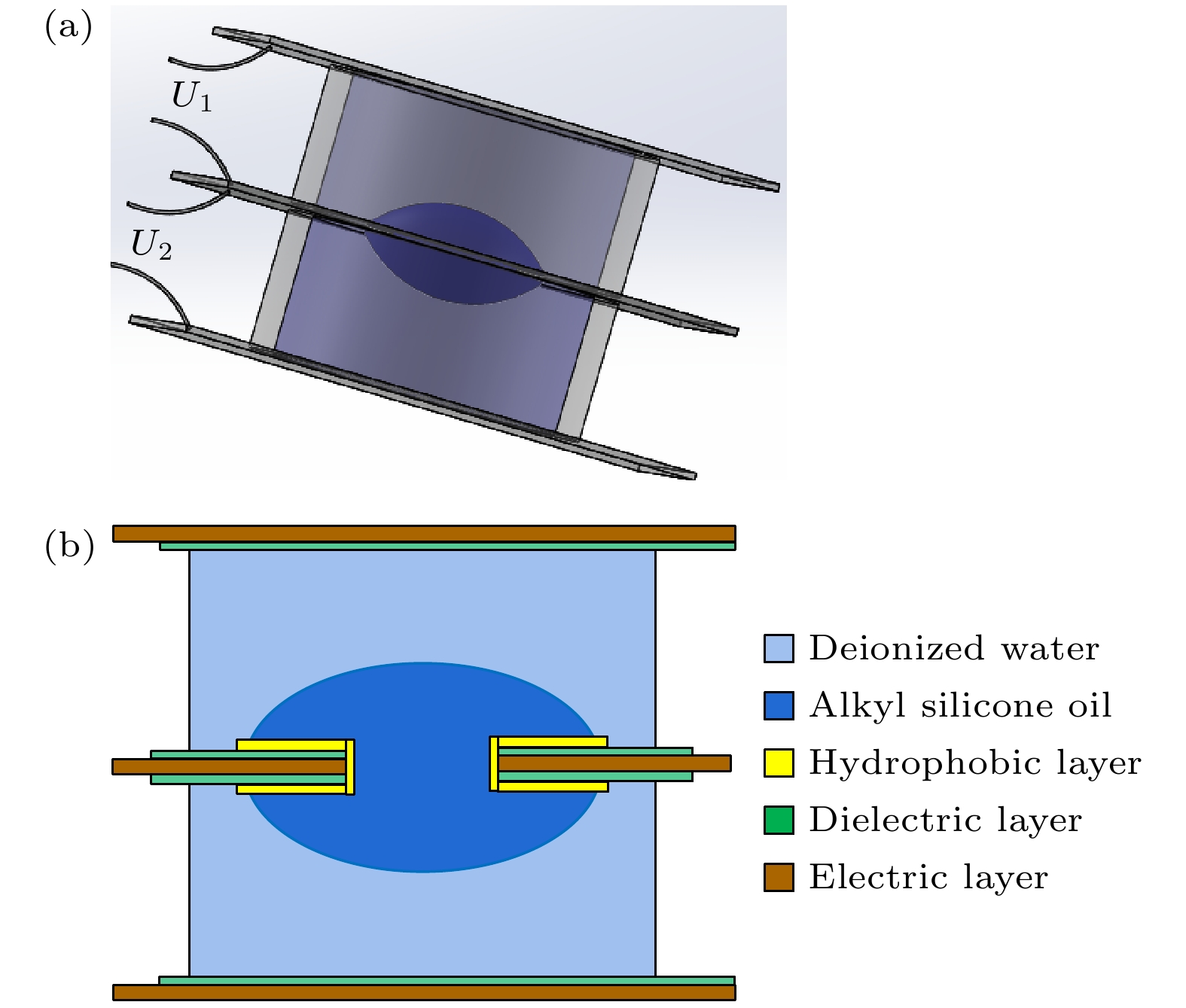
 下载:
下载:

